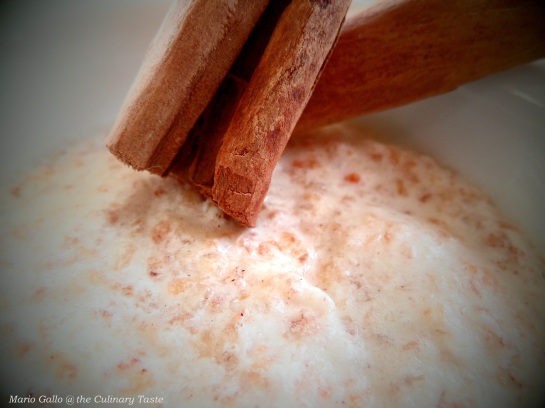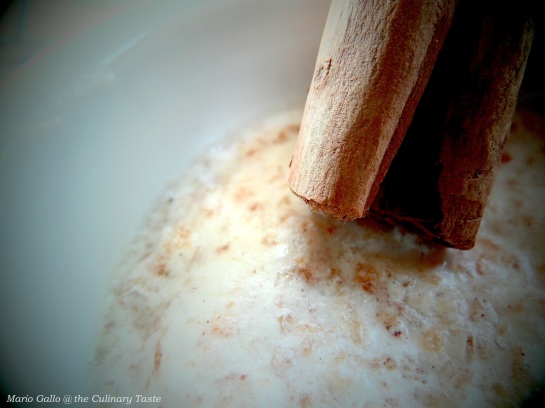Do you remember the bunch of rhubarb from my garden? The one mentioned here. Well, it has finally been turned into something. Something really tasty, refreshing and very, very summery: stewed rhubarb. That, incidentally, has been turned into an article on Honest Cooking as well (bear with me: I’ll talk about HC now and then in this blog).
Soft Desserts
Vanilla Persimmon Mousse
Autumn should be called the orange season: all fruits and foliages are but shades of blazing reds and bright yellows, oranges and browns. Pumpkins, pomegranates, persimmons cheer up dinners with their flaming colors and delicious tastes. Persimmons are one of the commonest fruits of the season. You can find persimmon trees in many old Tuscan gardens, together with pomegranate and apple trees. Vanilla persimmons are a rarer variety and, despite their name, their flavor has nothing to do with vanilla. Their flesh is crunchy and hard like apples, unlike common persimmons that resembles peaches.
I saw vanilla persimmons at the market and wanted to give them a try: I had no idea neither how they tasted like nor how they would come out in a mousse form, but I was too curious and they were so beautiful. Well, in the end I was satisfied with the result: their savor is not particularly strong (it’s rather delicate, I dare say) but it matched pretty well with cream and Malvasia. If you’re looking for something different, they’re worth giving a try.
Ingredients
200 g vanilla persimmons
250 ml whipped cream
100 ml milk
100 g vanilla sugar
1 tbsp Malvasia wine
1 cinnamon stick
Preparation time: 40 minutes
Refrigerating time: 2-3 hours
Serves 4
Wash, peel and remove seeds from persimmons. Mash them in a food processor. Simmer milk with sugar, cinnamon and Malvasia. Strain the milk and add it to persimmons; mix well. Stir in whipped cream. Pour mousse into dessert bowls and refrigerate for 2-3 hours before serving.
I made a mousse, but you can try to make a pudding, instead. You just need to add about 10 grams (or 2 sheets) of gelatine: soak gelatine in water at room temperature till soft, squeeze it and stir it into the lukewarm milk. Then add milk to persimmons and proceed as explained above.
Mousse di Cachi Vaniglia
L’autunno dovrebbe essere chiamato la stagione arancione: foglie e frutti non sono altro che toni di rossi fiammanti e gialli accesi, di arancioni e di marroni. Zucche, melagrane e cachi rallegrano le tavole con i loro colori fiammanti e i loro sapori deliziosi. I cachi, in particolare, sono tra i più comuni frutti di questa stagione e se ne trovano in molti vecchi giardini toscani, assieme ai meli e ai melograni. I cachi vaniglia sono una varietà più rara e, nonostante il nome, il loro sapore con la vaniglia non ha niente a che fare. La loro polpa è croccanre e dura come quella delle mele, a differenza dei cachi comuni che sono morbidi e ricordano le pesche.
Ho trovato i cachi vaniglia al supermercato e mi è venuta voglia di provarli: non avevo idea di che sapore avessero né di come sarebbero venuti fuori in una mousse, ma ero troppo curiosa e loro erano bellissimi. Beh, alla fine sono soddisfatta del risultato: il sapore non è particolarmente forte (anzi, è piuttosto delicato), ma si sposa bene con la panna e la Malvasia. Se cercate qualcosa di diverso, vale la pena di provare.
Ingredienti
200 g di cachi vaniglia
250 ml di panna montata
100 ml di latte
100 g zucchero alla vaniglia
1 cucchiaio di Malvasia
1 stecca di cannella
Tempo di preparazione: 40 minuti
Tempo in frigo: 2-3 ore
Per 4 persone
Lavare e pelare i cachi; togliere i semi. Passare i cachi al passaverdura o al mixer. Far riscaldare il latte con lo zucchero, la cannella e la Malvasia. Filtrare il latte e aggiungerlo ai cachi. Aggiungere mescolando la panna montata. Versare nelle coppette e tenere in frigo per 2-3 ore prima di servire.
Io ho preparato una mousse, ma volendo si può fare un budino. Basta aggiungere circa 10 grammi (2 fogli) di colla di pesce (gelatina alimentare): tenere in ammollo la gelatina in acqua a temperatura ambiente fino a quando diventa morbida, strizzarla e scioglierla nel latte tiepido. Aggiungere il latte ai cachi e procedere come spiegato sopra.
Strawberry Tiramisù
Tiramisù is one of Italian traditional desserts: it’s fresh, easy to make and absolutely delicious. And, as its name claims, really ‘lifts you up’. Its main ingredient is mascarpone, a triple-cream cheese originally produced in the area of Lodi (Lombardia) in Northern Italy, which is turned into a scrumptious cream only by adding eggs and sugar. Tiramisù is made by alternating layers of mascarpone cream and biscuits, traditionally soaked in coffee or Alchermes – the Italian crimson-colored liquor prepared by infusing neutral spirits with sugar, cinnamon, vanilla, cloves and kermes, the dye of animal origin that gives the characteristic color and name to the liquor. The biscuits conventionally employed in making tiramisù are the so-called Savoiardi, but I prefer Pavesini because they are thinner and can be better soaked. Of course, if you can’t find either of them, you can choose any kind of biscuits you like, provided they are spongy enough to be well soaked.
For this strawberry version I must thank a friend of my mother’s who gently passed the recipe to us (now we only make this kind of tiramisù!). Basically, it has the same quantities and ingredients of a traditional tiramisù, that is 100 grams of mascarpone for each egg and for each spoon of sugar; only the soaking liquid is different. As it’s made with strawberries, this ought to be a summer dish, but strawberries can be found all year round, so it’s perfect whenever you feel like.
The ingredients below serves 6-8 persons, but remember, tiramisù is never enough, so the more you make the more people will eat!
Ingredients
500-600 g strawberries
500 g mascarpone
5 eggs
7 tbsps sugar
200-250 g Pavesini biscuits
pinch of salt
cocoa powder to decorate
Preparation time: 20-30 minutes
Resting time: about 1-2 hours
Refrigerating time: 1-2 hours
Wash the strawberries; remove stalks and cut fruits into small pieces. Put them in a bowl and stir in 2 tablespoons of sugar. Let the strawberries rest in the fridge for about an hour or more, until fruit juices are released (the more you wait, the more juices you have).
Separate egg yolks from whites. In a bowl combine egg yolks and 5 tablespoons of sugar. Stir in mascarpone and mix well.
In another bowl, beat the egg whites with an electric beater till they’re stiff and resemble whipped cream (egg whites are better and more easily beaten if you add a pinch of salt before starting). Stir the withes into the mascarpone mixture and mix well.
Mash the strawberries into a puree with a stick blender (or a food processor). In a large and high-rimmed dish spread a thin layer of mascarpone cream. Soak the Pavesini biscuits one at a time into the strawberry puree and form a layer of biscuits over the first mascarpone layer. Spread a thick layer of mascarpone and again a layer of puree-soaked biscuits. End with a last thick layer of mascarpone. At the end of preparation, you should have five alternating layers: three layers of mascarpone and two layers of puree-soaked biscuits.
Keep refrigerated for at least an hour or two before serving. Sprinkle cocoa powder on top for decoration. For a better result, sprinkle cocoa powder right before serving the tiramisù, otherwise it will be absorbed by the mascarpone cream.
Tiramisù alle fragole
Il tiramisù è uno dei dolci tipici italiani: è fresco, facile da preparare e assolutamente delizioso. E, come dice il nome, tira proprio su. L’ingrediente principale è il mascarpone, un tipo di formaggio cremoso originario della zona di Lodi, in Lombardia, che viene trasformato in una favolosa crema aggiungendo solo uova e zucchero. Il tiramisù si prepara alternando strati di crema al mascarpone e biscotti, di solito inzuppati nel caffè o nell’Alchermes – il liquore color cremisi preparato con succhero, cannella, vaniglia, chiodi di garofano e cocciniglia, il colorante di origine animale che da il nome e la sfumatura al liquore. Tradizionalmente, i biscotti impiegati nella preparazione del tiramisù sono i Savoiardi, ma io preferisco i Pavesini perché sono più fini e si inzuppano meglio. Ad ogni modo, se non riuscite a trovarli, va bene qualunque altro tipo di biscotti, purché siano spugnosi.
Per questa versione alle fragole, devo ringraziare un’amica di mia madre che ci ha gentilmente passato la ricetta (ora mangiamo solo questa!). Fondamentalmente, ha le stesse dosi di un tiramisù tradizionale al caffè o all’Alchermes, cioè 100 grammi di mascarpone per ogni uovo e per ogni cucchiaio di zucchero; cambia soltanto il liquido. Dato che è fatto con le fragole, dovrebbe considerarsi un piatto estivo, ma visto che ormai le fragole si trovano tutto l’anno, lo si può fare ogni volta che si vuole.
Le dosi qui sotto bastano per 6-8 persone, anche se il tiramisù non basta mai. Anzi, più se ne fa e più se ne mangia!
Ingredienti
500-600 g di fragole
500 g di mascarpone
5 uova
7 cucchiai di zucchero
200 g di Pavesini
una presa di sale
cacao in polvere per decorare
Tempo di preparazione: 20-30 minuti
Tempo di riposo: 1-2 ore
Tempo in frigo: 1-2 ore
Lavare le fragole; togliere il picciolo e tagliare la frutta a piccoli pezzi. Metterli in una ciotola e aggiungere mescolando 2 cucchiai di zucchero. Lasciar riposare le fragole in frigorifero per un’ora o più, fino a che viene rilasciato il succo della frutta (più le fragole riposano, più succo viene prodotto).
Separare gli albumi dai tuorli. In una ciotola mescolare i tuorli con i cinque cucchiai di zucchero. Aggiungere il mascarpone e mescolare bene.
In un’altra ciotola montare gli albumi a neve (aggiungere una presa di sale per montarli meglio). Versare gli albumi montati nella crema al mascarpone e mescolare.
Passare le fragole con un passaverdure elettrico fino ad ottenere una purea. In una pirofila ampia e dai bordi alti, stendere un sottile strato di crema al mascarpone. Inzuppare i Pavesini uno alla volta nella purea di fragole e formare uno strato di biscotti sopra il primo strato di mascarpone. Stendere un altro strato di mascarpone più spesso e ancora uno strato di biscotti inzuppati nella purea. Terminare con un ultimo strato di mascarpone. Alla fine della preparazione, devono esserci cinque strati alternati: tre di mascarpone e due di biscotti.
Tenere in frigo almeno per un’ora o due prima di servire. Spolverizzare con cacao in polvere (perché il cacao non venga assorbito dalla crema, spolverizzare giusto un attimo prima di servire).






